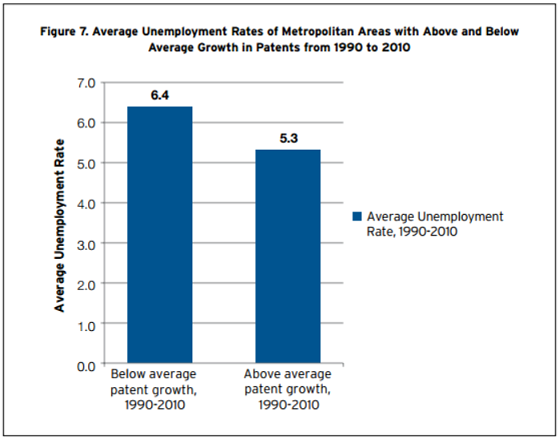Innovation and the Economy
The Brookings Institution recently released a study in which it concluded that there is a strong connection between innovation and the economy. We have previously discussed patent rate as a measure of innovation. The Brookings study shows that in areas where there is a high patent rate there is also higher productivity growth, lower unemployment and formation of higher value publicly traded companies (creation of wealth).
The study also suggests that if low-patenting areas, such as Nevada, were able to become high-patenting areas, the average worker would have about $4,300 of additional income per year. If Nevada began patenting as much as higher patent rate areas, its economic growth would likely be boosted by 6.5% over a ten year period.
Of course, correlation is not the same as causation. The study shows a correlation between a high patent rate and economic growth, but a high patent rate alone does not create economic prosperity. Merely obtaining more patents will not lead to economic growth. Rather, a high patent rate is the result of many factors, such as long term planning and investment by government and businesses in education, research and development, which also lead to economic growth.
Patent Quality
One area in which we disagree with the study is its analysis of patent quality. The study concludes that higher quality patents have a greater effect on economic performance. We don’t disagree with that conclusion, rather we disagree with the way the study quantified high quality patents. The study appears to equate patent quality with the number of claims in a patent.
Patent claims have a larger effect on metropolitan productivity than patents themselves. This makes sense if one considers that a patent with many claims is akin to multiple patents with few claims. In fact, after accounting for the number of claims, patents do not add value to a metropolitan economy.
Every patent has at least one claim in which the patented invention is described in a legal format. Under patent law, applicants for utility patents are allowed to include a large number of claims. However, the number of claims does not necessarily have anything to do with the quality of the patent or the underlying invention.
While it is a good practice to include a number of claims, especially different kinds of claims, a strong invention can be well protected with just one claim. Furthermore, there are many weak patents that have an excessive number of claims; many of the claims being directed to trivial variations. The study also seems to ignore design patents, which have only one claim.
Although the number of claims in a patent is an easy statistic to obtain and work with, the number of claims is influenced by many different things, such as:
- Patent office fees charged for additional claims
- The strength of the prior art
- The applicant’s goals, budget and situation
- The claim drafting style of the applicant’s attorney
- Recent court cases
Therefore, the number of claims in a patent does not necessarily indicate the quality of the patent.


